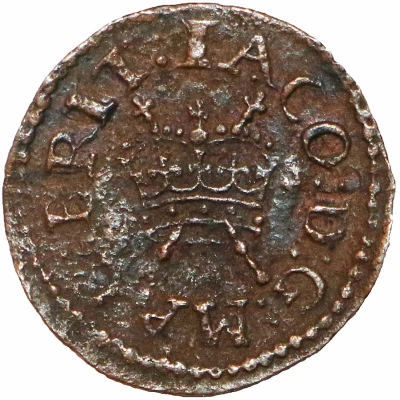


© John Conduitt (CC BY-SA)
1 Farthing - James I Lennox issue; type 3 ND
| Copper | 0.6 g | 16 mm |
| Issuer | England (United Kingdom, British Overseas Territories and Crown Dependencies) |
|---|---|
| King | James I (1603-1625) |
| Type | Token |
| Years | 1616-1623 |
| Value | 1 Farthing (1⁄960) |
| Currency | Pound sterling (1158-1970) |
| Composition | Copper |
| Weight | 0.6 g |
| Diameter | 16 mm |
| Shape | Round (irregular) |
| Technique | Hammered |
| Orientation | Variable alignment ↺ |
| Demonetized | Yes |
| Updated | 2024-10-09 |
| Numista | N#326060 |
|---|---|
| Rarity index | 90% |
Reverse
Crowned eagle-headed harp centrally with legend around. 5 jewels on crown, no mintmark.
Script: Latin
Lettering:
Rev. 1: FRA:ET HIB:REX·
Rev. 2: FRA:ET.HIB:REX·
Unabridged legend: Franciae Et Hiberniae Rex
Translation: France and Ireland (continuation of obverse legend)
Comment
House of Stuart (1603-49), James I (1603-25), copper farthing token, production contracted to Lord Lennox.Everson type 3, BMC (Peck) Lennox type 3c.
Type 3 is distinguished from other Lennox farthings in that the privy mark is on the obverse only and there are 5 jewels on the band of the crown on both sides. There are many privy marks:
Die axis 0°: annulet, coronet, cross patée fourchée, dagger, eagle’s head, fusil, key - horizontal, trefoil, tun, woolpack.
Die axis 180°: cross flory fitchée, cross patée fourchée, fusil, lion passant, quatrefoil, double rose, roundel, thistle head, turtle.
Most James I farthing counterfeits are Type 3 or later. A genuine Lennox Type 3 has an eagle-headed harp with 6-strings and correct die rotation. Punctuation can give counterfeits away (colons ‘:’ or '!' should only appear after abbreviations such as D, BRIT and FRAN).
Counterfeit Privy Marks: Lombardic A, crescent, plain cross, lys, mascle, 4 pellets, roundel with BRIT, star, stirrup, triangle, no mark and most with trefoil
Interesting fact
One interesting fact about the Token 1 Farthing - James I (Lennox issue; type 3) ND (1616-1623) from England (United Kingdom, British Overseas Territories and Crown Dependencies) made of Copper weighing 0.6 g is that it was issued during a time of great economic turmoil in England. The early 17th century saw a severe shortage of small change, which led to the issuance of private tokens, like this one, by merchants and traders to fill the gap. This coin, in particular, was issued by the Earl of Lennox, who was a prominent Scottish nobleman and a member of the royal family. Despite its small denomination, the coin was made of copper, which was a valuable resource at the time, and its design featured an image of the king, James I, on one side and a cross on the other. This coin is a rare and interesting example of the diverse and innovative ways that people have used currency throughout history to facilitate trade and commerce.



